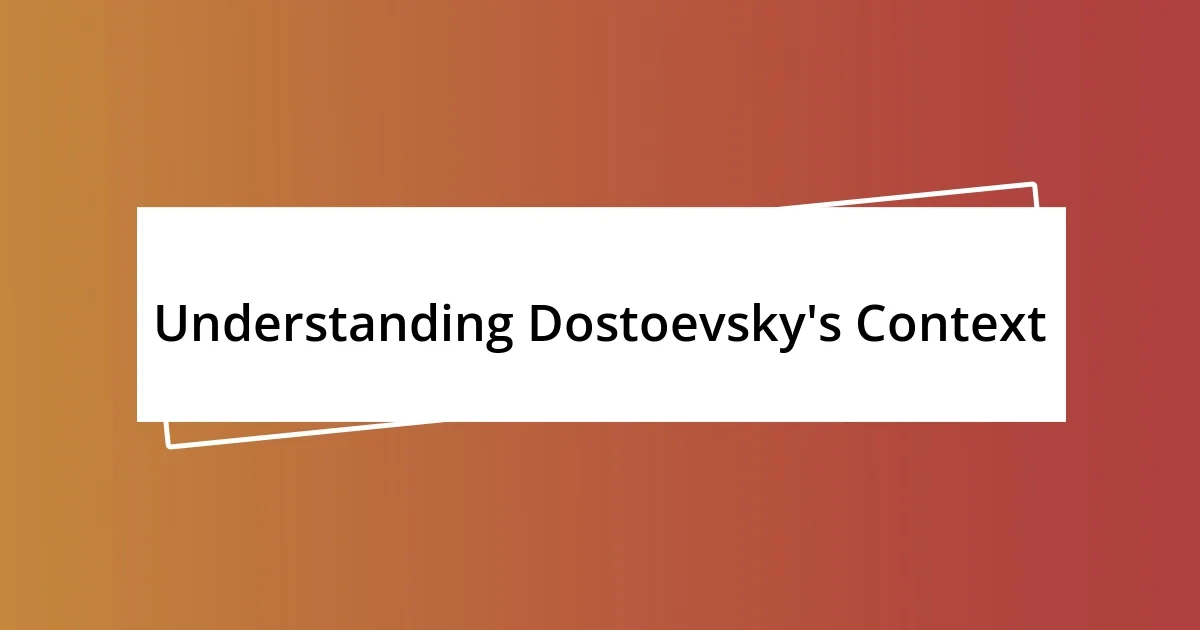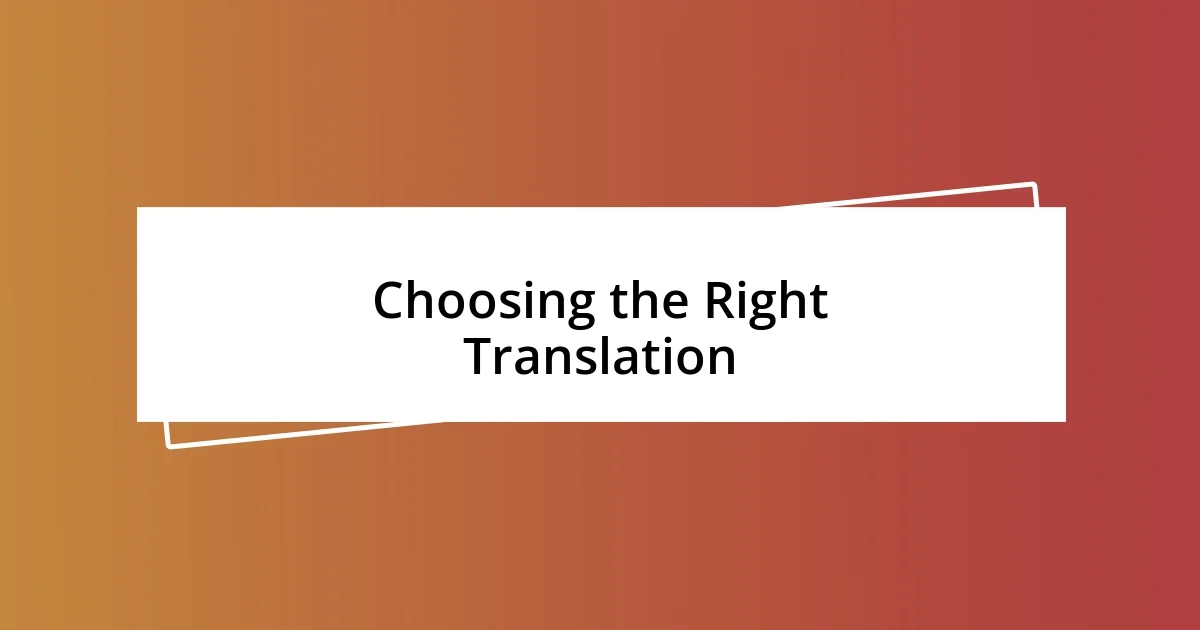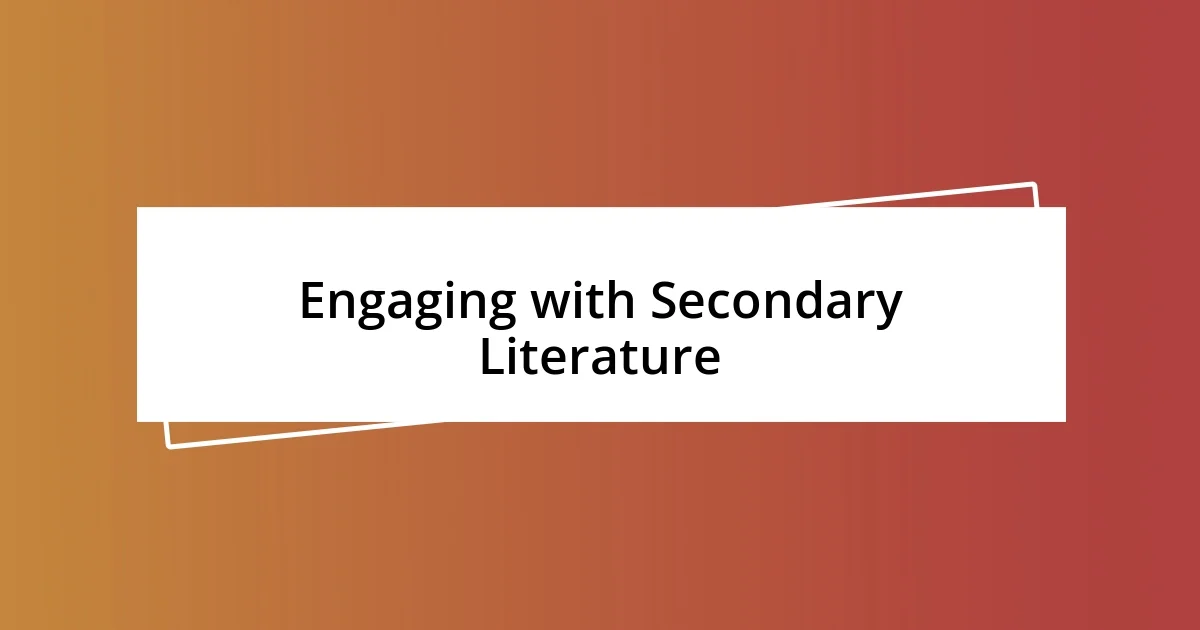Key takeaways:
- Dostoevsky’s context of 19th-century Russia significantly influences his characters, reflecting societal upheavals and moral dilemmas that resonate with contemporary struggles.
- Choosing the right translation and engaging with secondary literature enhances comprehension and appreciation of Dostoevsky’s complex themes and characters.
- Personal reflection and discussions with others about Dostoevsky’s narratives can lead to deeper insights into one’s values, beliefs, and emotional journeys.

Understanding Dostoevsky’s Context
When I first dived into Dostoevsky’s world, I was often struck by the shadows of 19th-century Russia that echoed in his works. The societal upheaval, intellectual debates, and moral dilemmas of that time seeped into his characters’ struggles. Have you felt that overwhelming sense of tension that pulses through the pages? It’s a reflection of a society grappling with rapid change and existential questions.
Examining Dostoevsky’s context, particularly the harsh realities of poverty and the philosophical turmoil of his era, opened my eyes to the depth of his characters’ pain. I remember reading “Crime and Punishment” and feeling a mix of pity and frustration toward Raskolnikov, as he wrestled with his theory of being an “extraordinary man.” It made me question: what would I sacrifice for my beliefs? This clash with morality and suffering is not just a historical backdrop; it resonates with our contemporary struggles as we navigate our own ethical landscapes.
Additionally, Dostoevsky was deeply influenced by personal experiences, including his own brushes with death and imprisonment. Reflecting on how these experiences shaped his worldview, I found a profound connection to my own life—moments when crisis led me to introspection. Could it be that, like Dostoevsky, we often find our most authentic selves at the edge of despair? This question certainly lingers in the air as we unravel the complex layers of his narrative.

Choosing the Right Translation
Choosing the right translation of Dostoevsky’s works can significantly shape your reading experience. I learned this the hard way when I picked up a version that felt flat, robbing the text of its emotional weight. It wasn’t until I discovered a translation that captured the nuances of his language and understood the cultural context that I truly appreciated the depth of his narratives.
Here are some key considerations when selecting a translation:
- Translator’s Background: A translator with a strong grasp of Russian culture and literature can provide richer insights into the text.
- Language Style: Some translations aim for literal accuracy, while others prioritize readability. Decide what matters most to you.
- Footnotes and Annotations: Translations that include contextual notes can enhance your understanding of intricate themes and historical references.
- Reviews and Recommendations: Look for critiques and suggestions from fellow readers to find translations that resonate with your experience.
- Sample Pages: If possible, read a sample from different translations to see which style feels most engaging to you.
Making the right choice can transform your encounter with Dostoevsky, turning a challenging read into a profound journey.

Building a Reading Schedule
When building a reading schedule for Dostoevsky’s works, I find it essential to carve out specific time slots that align with my energy levels. For instance, late evenings work wonders for me; the stillness allows me to absorb his intricate prose without distractions. Have you noticed how some moments seem more conducive to deep thinking than others? By identifying your peak concentration times, you can create a personalized reading routine that feels less like a chore and more like a ritual.
I often break my reading into manageable chunks. Dostoevsky’s narratives can be dense, so I aim for about 30 pages a session. This approach allows me to reflect on what I’ve read without feeling overwhelmed. It’s like savoring a rich dessert instead of devouring a whole cake in one go. Integrating pauses for internal dialogue or journaling my thoughts about characters or themes can transform a simple reading session into a meaningful exploration of my interpretation.
To give you a clearer picture, I’ve put together a simple comparison table. It summarizes my reading schedule versus a more rigorous approach, showing how different strategies can impact your experience with Dostoevsky.
| My Flexible Schedule | Rigorous Schedule |
|---|---|
| 30 pages per session, reflecting afterward | 100 pages per day, little reflection |
| Evenings as the prime time for reading | Mornings or whenever I have free time |
| Weekly check-ins to discuss with friends | No interaction, reading in isolation |

Taking Effective Notes
When it comes to taking effective notes while diving into Dostoevsky’s complex narratives, I’ve found a few strategies that truly elevate my reading experience. I prefer jotting down insights or passages that resonate with me emotionally—instead of summarizing entire chapters, I focus on capturing the essence. For example, when I encountered Raskolnikov’s internal conflict in Crime and Punishment, I noted my feelings of empathy and confusion alongside the relevant quotes. This way, my notes serve as a mirror reflecting my emotional engagement with the text.
I also use a combination of digital and handwritten notes. There’s something remarkably grounding in the act of writing by hand—it helps me process the material differently. When I was grappling with the themes of suffering in The Brothers Karamazov, my handwritten notes became a canvas for my reflections, complete with arrows connecting ideas and doodles that expressed the tumult in my mind. On the other hand, I’ll type up key concepts and themes later, making them easy to search and revisit. It’s all about what feels right for you; have you thought about how you best retain information?
Color coding has been another game-changer. Each character or theme has a designated color that allows me to see connections at a glance. It might sound quirky, but I found that highlighting Alyosha in blue and Ivan in red made me more aware of their contrasting philosophies during the reading. When I look back at my notes, those colors pop, reminding me of their battles and resolutions. This technique keeps my notes visually engaging, ensuring that I can quickly refer back to them when I revisit the text or discuss it with others.

Engaging with Secondary Literature
Engaging with secondary literature can truly enhance my understanding of Dostoevsky. I remember the first time I picked up a critical analysis of The Idiot. It felt like I was having a conversation with someone who shared my curiosity and confusion about Prince Myshkin’s character. Bringing in scholarly perspectives not only deepened my insight but also transformed my own interpretations. Ever considered how a different viewpoint can shift your entire understanding of a character’s motivations?
Diving into commentaries and essays often leads to “a-ha!” moments. There was a time when I struggled with the existential themes in Notes from Underground, and then I discovered a commentary that brilliantly connected Dostoevsky’s ideas to modern concepts of self-awareness. That connection sparked something in me. I couldn’t help but wonder how many other layers I was missing without these secondary resources. Engaging with these texts challenges me to rethink my conclusions, nudging me to explore the nuances I might not have otherwise recognized.
Moreover, discussing secondary literature with friends or book clubs can be incredibly rewarding. I vividly recall a lively debate where we dissected various interpretations of suffering in The Brothers Karamazov. Hearing diverse opinions opened my eyes to angles I never considered. Have you tried turning your reading into a communal experience? Sharing insights often enriches my experience and helps solidify new ideas in my mind.

Discussing Themes with Others
Discussing Dostoevsky’s themes with others has always heightened my appreciation for his work. I vividly remember one evening, sitting around a table with friends after a book club meeting. We delved into the moral quandaries presented in Crime and Punishment, and as we exchanged viewpoints, I felt an exhilarating mix of excitement and enlightenment. Seeing how others interpreted the motivations of Raskolnikov—some viewed him as a tragic hero while others labeled him a coward—forced me to reconcile my viewpoint with theirs. Have you ever found your interpretation of a story flipped on its head by someone else’s perspective?
I often find that these discussions can illuminate the darker, more complex themes Dostoevsky weaves into his narratives. For instance, during a recent chat about The Brothers Karamazov, I was struck by a friend’s comment about the theme of faith versus doubt. It resonated so deeply that I left the conversation questioning my own beliefs. Isn’t it fascinating how a simple dialogue can challenge the very core of our understanding? Engaging with others not only exposes me to fresh interpretations; it also scatters seeds of new ideas that germinate long after the conversation ends.
Through these discussions, I also realize how themes of alienation and existentialism permeate our modern lives. Recently, I recounted a moment from Notes from Underground while discussing feelings of isolation with a colleague. That exchange turned into a heartfelt conversation about our personal struggles and existential crises. It made me wonder: how much of Dostoevsky is reflective of contemporary life? These interactions enrich my understanding and create an emotional tapestry that makes reading his work so much more relatable and personal.

Reflecting on Personal Insights
Reflecting on my personal insights from reading Dostoevsky can be a journey filled with unexpected revelations. One night, after finishing Crime and Punishment, I sat by my window, contemplating Raskolnikov’s choices. That moment of quiet introspection led me to recognize the parallels between his internal struggles and some of my own life decisions. Have you ever found a character mirroring your thoughts so closely that it makes you question your own motivations?
As I delve deeper into Dostoevsky’s worlds, I often find myself wrestling with the concept of suffering. I recalled a particularly challenging time in my life when I felt overwhelmed by despair. Reading The Brothers Karamazov during that period was eye-opening; it provided me with a lens to channel my experiences into a broader discussion about the human condition. Isn’t it remarkable how literature can serve as both a mirror and a lighthouse, guiding us through our darkest moments?
The emotional weight of Dostoevsky’s narratives prompts a reflection on my values and beliefs. I remember discussing the theme of redemption in The Idiot with an old professor, who shared insights that shifted my perspective entirely. His thoughts made me ponder whether redemption is a linear path or a series of complex choices we navigate throughout life. Isn’t it curious how a simple conversation can unearth beliefs that lie beneath the surface? Exploring these layers enhances my connection to Dostoevsky’s work and deepens my understanding of my own journey.














